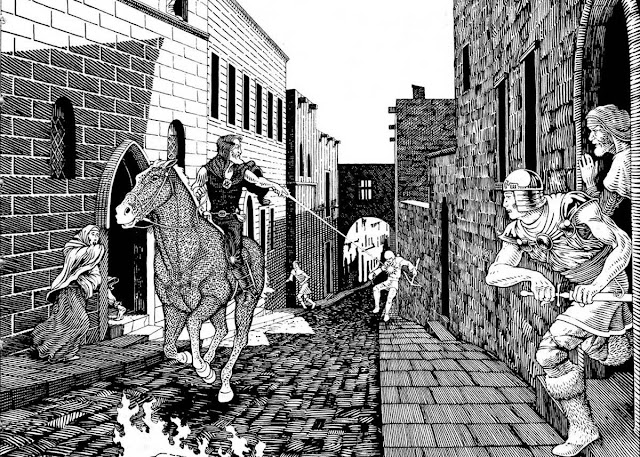I’m challenging conventional wisdom that AD&D by-the-book combat is too difficult! In this episode, I visit initiative one more time to talk about melee with a spell-caster, and then I cover charging.
Anchor Episode link: https://anchor.fm/the-dungeon-masters-handbook/episodes/Episode-25—ADD-Combat-Demystified—Initiative-for-Spellcasting–Charging-eaaja5
Leave me a voice message and let me know what you think! (312) 625-8281 (US/Canada)
Leave a message on Anchor: anchor.fm/the-dungeon-masters-handbook/message
Links from episode:
My AD&D Combat Cheat Sheet: https://drive.google.com/open?id=1buc4Iubou-bH7V1Ud-h_4SkHm9wfm64a
Outro music: Dream by Wild Shores (bit.ly/2jbJehK)

Just listened to this podcast and I love the way you go through the rules. It is just what I need to be able to easily go and reread them to really understand them. After re-reading the rule on spell casting in melee I have found out that there might be a significantly more intuitive way to think about it.
What we really measure by subtracting the initiative from the weapon speed factor is how many segments it takes for the weapon to resolve counting from the start of the spellcasting. But keep in mind that the weapon speed factor (for this intent) is also the absolute segment in the round where it resolves. This means that we will get the same result by adding the initiative to the spell to find out the absolute segments in the round in which the spell is cast and resolved.
– Magic user decides to cast a spell with 3 segment cast time
– Initiative rolled: 4 and 3
– The MU's side wins initiative and goes on segment 3. He will therefore be casting his spell from segment 3 to segment 6 (counting 3 segments of cast time starting from 3: 4, 5, 6).
– If his opponents had decided to attack him using any weapon with a WSF lower than 6, they had a chance to disrupt the spell. This can be visually illustrated like so:
▢▢▥▥▥▣▢▢▢ Spell cast on initiative 2 with a cast time of 3 segments
▢▣▢▢▢▢▢▢▢ Weapon with WSF of 2 comes before spell (6) and can ruin it
▢▢▣▢▢▢▢▢▢ Weapon with WSF of 3 comes before spell (6) and can ruin it
▢▢▢▢▢▣▢▢▢ Weapon with WSF of 6 resolves simultaneous with spell (6)
▢▢▢▢▢▢▣▢▢ Weapon with WSF of 7 comes after spell (6)
Hey Sebastian, that's pretty aweseome!
I'm going to have to chew through this, because I'm not convinced that the weapon speed *should* be thought of as starting from when the spell starts. In a way, it kind of defeats the purpose of initiative, at least to how I think of it. If I'm attacking you and you're casting a spell, I shouldn't be counted as acting until my segment is reached. Then, on my segment, if I can strike you before you get the spell (using weapon speed as determinant), then that's all good.
Let me play around with this, but I love that you laid it all out and now I'm curious as to how various scenarios would look either way.
I was a bit confused about this also as my first assumption would be to subtract the segment that the sword-user acts on (the magic-user's initiative roll).
But looking through Gygax's example I am pretty sure the initiative that is subtracted from the WSF is always the segment the magic-user act on (the sword-wielder's initiative roll). I think all of his examples from the book are based upon the assumption first stated that "side A, which has achieved initiative (action) for the round, has a magic-user engaged in casting a spell" and as he puts it, it is the "losing initiative roll" that is subtracted.
If you are curious about the examples from DMG page 67, I did try to lay out out all those in the same way to see if they were equivalent. It turns out there was one thing I did not count on: That negative numbers are counted as positive. This means that the casting time would be added in both "directions" of the timeline if using this system.
▢▢▢▢▣▢▢▢▢ WSF5
F ▥▥▣▢▢▢▢▢ Fireball segment 1: spell prior to weapon
▥ F ▥▥▣▢▢▢▢ Fireball segment 2: simultaneous
▥▥ F ▥▥▣▢▢▢ Fireball segment 3: weapon prior to spell
▣▥▥ F ▥▥▣▢▢ Fireball segment 4: weapon prior to spell
▢▣▥▥ F ▥▥▣▢ Fireball segment 5: weapon prior to spell
▢▣▢▢▢▢▢▢▢ WSF2
F ▥▥▣▢▢▢▢▢ Fireball segment 1: weapon prior to spell
▥ F ▥▥▣▢▢▢▢ Fireball segment 2: weapon prior to spell
▥▥ F ▥▥▣▢▢▢ Fireball segment 3: weapon prior to spell
▣▥▥ F ▥▥▣▢▢ Fireball segment 4: weapon prior to spell
▢▣▥▥ F ▥▥▣▢ Fireball segment 5: simultaneous
▢▢▢▢▢▢▢▢▣ WSF9
F ▥▥▣▢▢▢▢▢ Fireball segment 1: spell prior to weapon
▥ F ▥▥▣▢▢▢▢ Fireball segment 2: spell prior to weapon
▥▥ F ▥▥▣▢▢▢ Fireball segment 3: spell prior to weapon
▣▥▥ F ▥▥▣▢▢ Fireball segment 4: spell prior to weapon
▢▣▥▥ F ▥▥▣▢ Fireball segment 5: spell prior to weapon
Considering this part about the negative numbers, I don't know if it becomes more intuitive after all. But it was a fun exercise 🙂
I also found a typo in my example from the earlier post. In the first line of the laid-out example it should say "Spell cast on initiative 3". Sorry for the confusion.